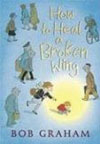|
How to Heal a Broken Wing

Last updated Wednesday, June 2, 2010
Author: Bob Graham
Date of Publication: 2008
ISBN: 0763639036
Grade Level: Kindergarten (GLCs: Click here for grade level guidelines.)
Date(s) Used: Jun. 2010
Synopsis:
Quietly, effectively, Graham tells the simple story of a boy who finds a fallen bird and nurses it back to health. The text is minimal. In a busy city, “No one saw the bird fall.” But a little boy walking with his mother spies the injured bird and brings it home. Up until this point, the art has effectively utilized the oversize format, filling it with full-page pictures, vertical and horizontal strips, and cartoon-style boxes in cloudy hues. At the moment the boy lifts the bird, Graham slows the story and offers a two-page spread full of bright, hopeful colors and an intense focus on the boy with the bird in hand. Turn the page and both mood and perspective change once more. Now the pages are full of people, walking, biking, rushing, while in an upper corner of the spread, encircled in a glow, readers find boy and bird; the unspoken, unwritten message is clear. Who cares in such a large place if a small pigeon falls? One child does. Although the rest of the story is a little anticlimactic, there is a satisfying reality to it as the bird is bandaged, heals, and is set free. Because this is such a visual piece, however, readers, young and old, will return to the story to look more deeply; they won’t be disappointed.
| Note to readers: |
| • |
The words in this story are very spread out across the pages, which may make it hard for the kids to follow.
|
| • |
You may want to read through the story more quickly without stopping to analyze pictures the first time, and then revisit to look at it more in depth.
|
| Discussion topics for before reading: |
| • |
Have you ever saved a bird or another animal who was hurt?
|
| • |
Who do you think the people on the cover are? What are they doing? Where are they?
|
| • |
What do you call an animal doctor (veterinarian)?
|
| Discussion topics for during/after reading: |
| • |
What kind of bird is the story about? Do you see them in your neighborhood?
|
| • |
Why do you think the bird flew into the building? What about the building made it more likely that he would run into it?
|
| • |
Where is the bird (page 1)
|
| • |
Have you ever seen a bird run into a window?
|
| • |
Why do you think no one saw the bird fall?
|
| • |
What is special about Will? Do you notice things that adults don’t?
|
| • |
How do think his mother feels about Will picking up the bird? What would your mother say?
|
| • |
Pages without words after Will picks up the bird--Stop and ask questions about what they notice about the pictures and the people? What are the adults doing while Will is picking up the bird?
|
| • |
Would your mom or dad let you take home a wild bird?
|
| • |
How do you think Will is going to help the bird?
|
| • |
What is dad doing to the box?
|
| • |
Look at the pictures as the bird is healing? How do you know time is passing? How do you know the bird is getting better?
|
| • |
What is the bird hoping for? What do you think Will and his parents are hoping for?
|
| • |
Where did Will release the bird? (where he found it) Why do you think he did that?
|
| • |
Do you think Will missed the bird when he set it free again? Why or why not?
|
| Craft ideas: |
| • |
Make a bird with a popup beak (see instructions on back of sheet)
|
| • |
Make feathers out of construction paper/magazine cutouts and make a collage.
|
| • |
Make bird masks with construction paper and glue on a beak.
|
| Special activities: |
| • |
If the kids get restless, have them fly around as birds with broken wings.
|
*Note: These craft ideas are just suggestions.
You can use them, but you don't have to use them.
You can expand upon them, or add your own twist.
Remember, though, that the focus of your time should
not be on the development and execution of a craft;
the focus should be on the read-aloud and the
enjoyment of the book!
|
